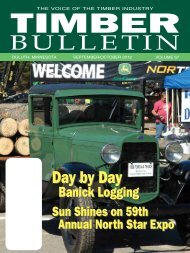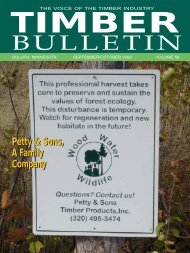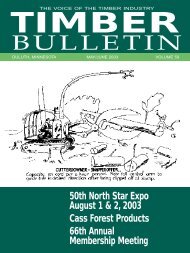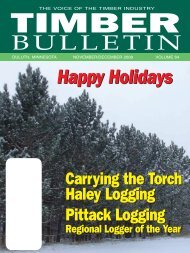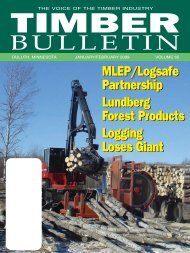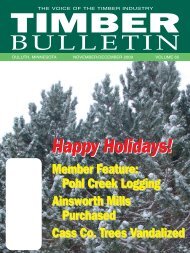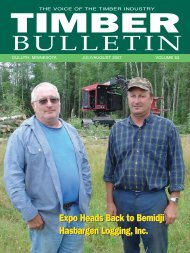Timber Bulletin Nov/Dec - Minnesota Forest Industries
Timber Bulletin Nov/Dec - Minnesota Forest Industries
Timber Bulletin Nov/Dec - Minnesota Forest Industries
- No tags were found...
You also want an ePaper? Increase the reach of your titles
YUMPU automatically turns print PDFs into web optimized ePapers that Google loves.
TPA Submits Guideline CommentsEditor’s Note: The following comment letter was submitted by TPA in response to the request for comments by the<strong>Minnesota</strong> <strong>Forest</strong> Resources Council. The comments were approved by the TPA board of directors at its <strong>Dec</strong>ember meeting.<strong>Minnesota</strong> <strong>Timber</strong> Producers Association903 Medical Arts Building • 324 W. Superior St. • Duluth, <strong>Minnesota</strong> 55802Phone 218-722-5013 • Fax 218-722-2065<strong>Dec</strong>ember 14, 2001Michael PhillipsCouncil Guideline Development CoordinatorMN DNR/Division of <strong>Forest</strong>ry500 Lafayette RoadSt. Paul, MN 55155-4044Dear Mr. Phillips:Following are the comments of the <strong>Minnesota</strong> <strong>Timber</strong> Producers Association on issues to be considered in the review of the<strong>Minnesota</strong> <strong>Forest</strong> Resources Council’s <strong>Timber</strong> Harvesting and <strong>Forest</strong> Management Guidelines:• Consideration should be given to increase the area for landings and roads as a means of decreasing the amount of skiddingthat needs to be done;• Consideration should be given to decreasing the amount of standing timber left around both open and non-open water wetlandinclusions in timber sales, we believe that this is having a substantial impact on volumes available for economical harvest;• The MFRC should review the overall environmental and economic advisability of harvesting on more acres to produce thesame volume of wood when less wood per acre is removed by following the current guidelines i.e. it may be better to harvestmore wood on fewer acres;• Consideration should be given to modifying the recommendation to utilize water bars even when ground is frozen, this notpractical or advisable and diversion may be better accomplished using other tactics (slash);• The riparian peer review that was done by the MFRC included information that the residual basal area guidelines were too highfor effective regeneration of many tree species, consideration should be given to revising this guideline by reducing theresidual basal area recommendations;• A more comprehensive index should be developed e.g. all references in the guidelines to “snags” or “leave trees” would beidentified;• The MFRC should consider modifying, eliminating or creating separate guidelines for small timber sales or timber sales thatare comprised of multiple small blocks;• The MFRC must complete a thorough economic analysis as required by MS 89A.05, including economic impacts, availability ofacres for management and providing stable, sustainable and predictable supplies of wood;• “Site” is not well defined for using the guidelines or for monitoring the use of the guidelines, “site” should include the entiremanagement unit of the sale area not just the area on which harvesting is being done;• Filter strip width recommendations should continue to be stated in ranges to recognize on the ground guideline application andminimum filter strip width recommendations should not be changed;• Minimizing compaction in filter strips or RMZ’s should be addressed in the guidelines by defining outcomes and not by layeringrestrictions e.g. winter harvest and special equipment;• Consideration should be given to adding trees with permanent deer stands to the list of preferred leave trees;• Changing thresholds for slopes and operations should only be done based on sound research as this will have significantimpacts, especially in southeastern <strong>Minnesota</strong>;• Consideration should be given to the impacts of seasonal pond guidelines on the cost of logging and losses of volume topublic and private landowners;• The guidelines should be changed to make it clear that “dry washes” are not subject to RMZ recommendations;• Extreme caution should be used in dealing with any proposals to remove riparian areas from active management as this willlikely have the effect of increasing economic pressures to convert important forestlands to non or less forested uses as a resultof development.TPA thanks the MFRC for the chance to provide these comments. We urge the MFRC to proceed with great caution. Currentlyloggers and the entire forest products industry are facing the most difficult economic situation we have seen for many years. TheMFRC should give strong consideration to reducing the cost of guideline implementation and be extremely reluctant to makechanges that increase costs to loggers, landowners or wood consumers.Sincerely,This paper is made from <strong>Minnesota</strong> trees.Clarence JohnsonPresident8 <strong>Timber</strong> <strong>Bulletin</strong> <strong>Nov</strong>ember/<strong>Dec</strong>ember 2001



